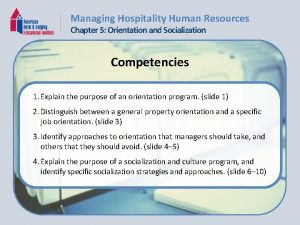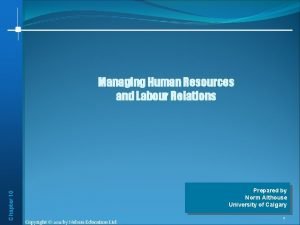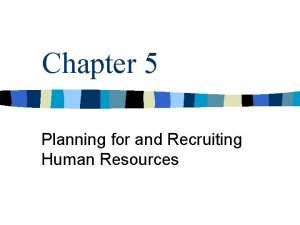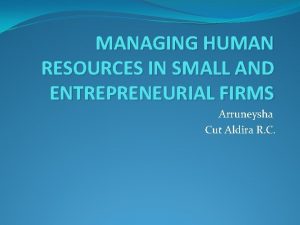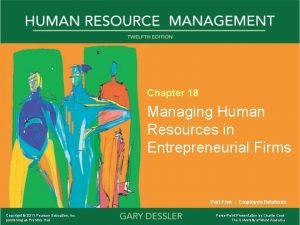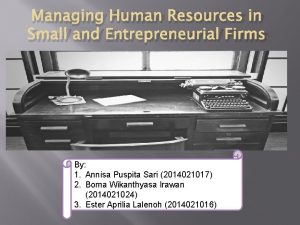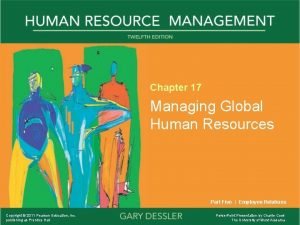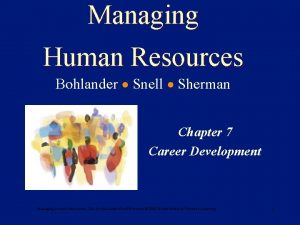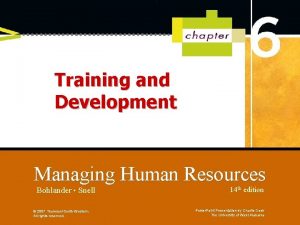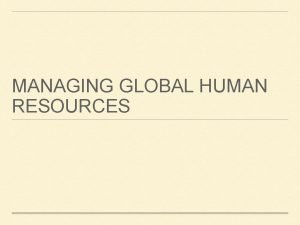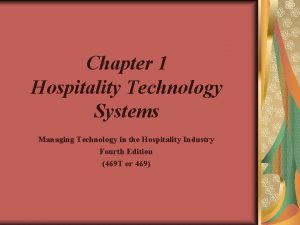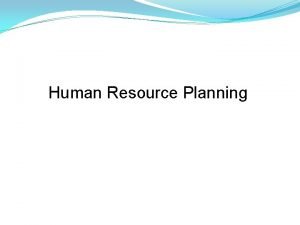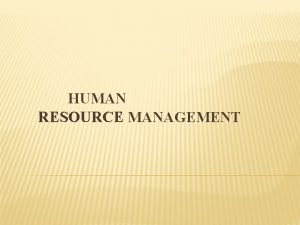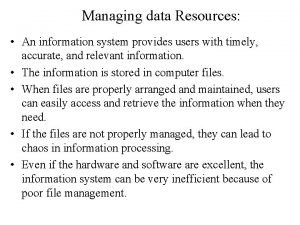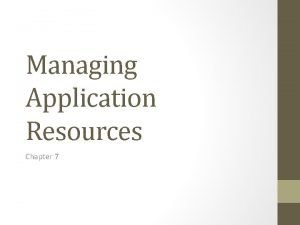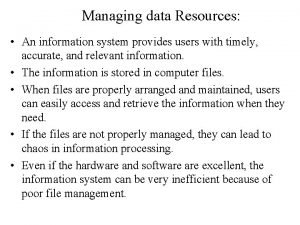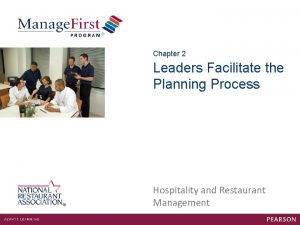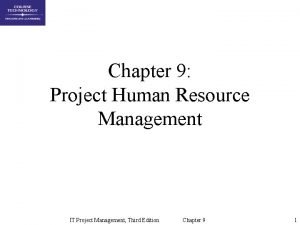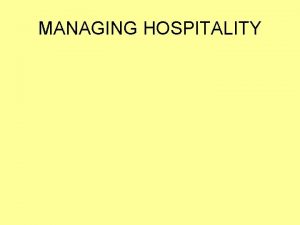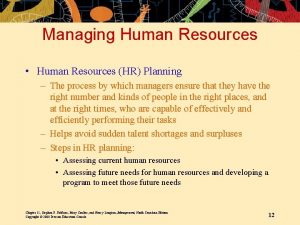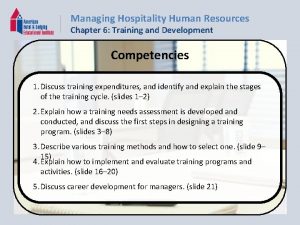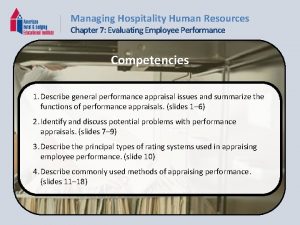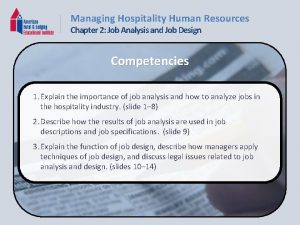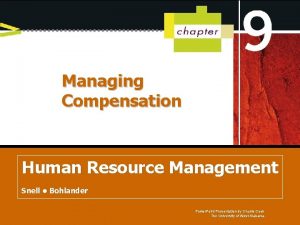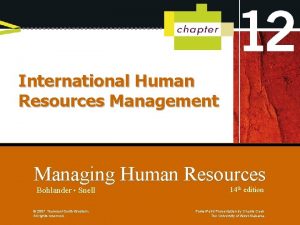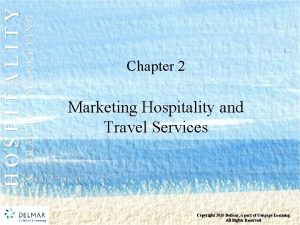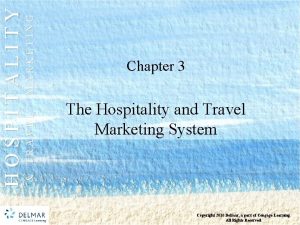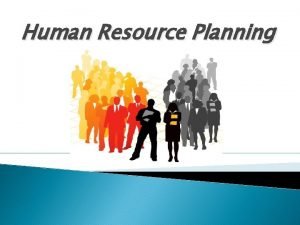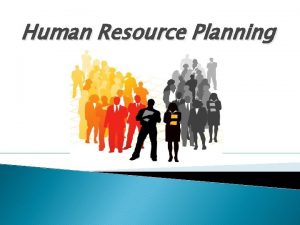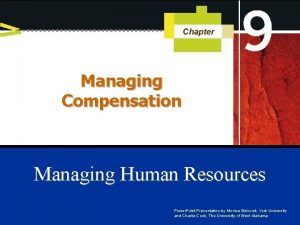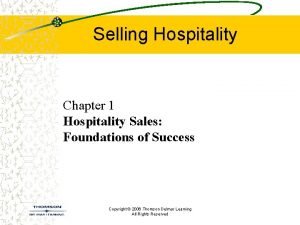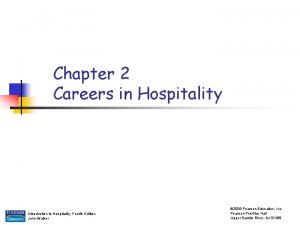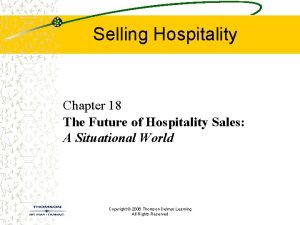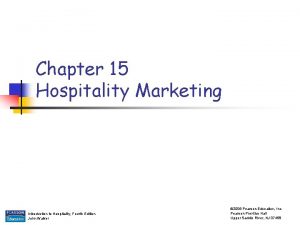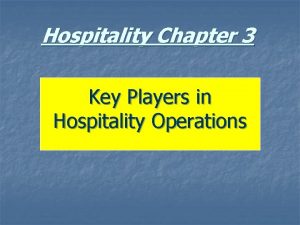Managing Hospitality Human Resources Chapter 3 Planning and





























- Slides: 29

Managing Hospitality Human Resources Chapter 3: Planning and Recruiting Competencies 1. Summarize supply and demand considerations managers should keep in mind when planning for human resource needs. (slide 1– 3) 2. Explain and apply methods forecasting labor demand. (slides 4– 5) 3. Describe what is involved in forecasting labor supply. (slides 6– 7) 4. Discuss recruitment, including internal and external recruiting issues, and describe recruitment sources. (slides 8– 21) 5. Explain recruiting from the applicant’s viewpoint, including what recruiters look for and how applicants can prepare for an interview. (slides 22– 26) 6. Identify the functions of a computer-based Human Resource Information System (HRIS). (slides 27– 28)

Managing Hospitality Human Resources Chapter 3: Planning and Recruiting Planning Human Resources • Human resources planning involves anticipating an organization’s business demands and providing the staff to meet them. • Supply represents the number of potential employees that are available to a hospitality company. • Demand represents the number and nature of the jobs that company needs. Slide 1

Managing Hospitality Human Resources Chapter 3: Planning and Recruiting External Factors Influencing Employee Supply and Demand • Starting in 2008, the following factors combined created the highest levels of unemployment in the U. S. since the Great Depression: • The recession eliminated many jobs and put millions of people out of work. • Baby Boomers who were projected to retire in record numbers and thus free up job positions have instead continued to work. • Generation Y (people born in the 1980 s to 2000) has started to look for permanent careers after staying in school or working at part-time jobs longer than previous generations. Slide 2

Managing Hospitality Human Resources Chapter 3: Planning and Recruiting Internal Factors Influencing Employee Supply and Demand • The Great Recession of 2008 has lessened job mobility; employees who have jobs want to keep them. • The recession has eliminated upward movement in many companies because employees with the best jobs are staying put. • Employee satisfaction is one of the most important factors that determine potential employee supply. Slide 3

Managing Hospitality Human Resources Chapter 3: Planning and Recruiting Forecasting Demand • The goal of forecasting is to accurately match the demand for employees and skills with the available supply. • Bottom-up forecasting is the process of asking managers within an organization to estimate their needs for the upcoming period. • Top-down forecasting relies on quantitative and statistical approaches. Slide 4

Managing Hospitality Human Resources Chapter 3: Planning and Recruiting Trend Analysis 1. Identify the appropriate business factor that relates to the number of personnel required. 2. Chart the historical record of how that factor relates to the size of the work force. 3. Chart the trend in room occupancy. 4. Compute the average labor productivity for the company. 5. Use the historical employee ratio to project future labor demand. 6. Make adjustments in the trend based on unusual events that may influence the estimate. Slide 5

Managing Hospitality Human Resources Chapter 3: Planning and Recruiting Internal Supply and Skills Inventories • Forecasting the internal supply of labor beings with an inventory of the present staff and their current skills and ability to learn new skills. • Skills inventories list each employee’s current skills, ability to learn new skills, qualifications, and career goals; to be effective: • They must be regularly updated. • Both managers and employees must agree on the information included in the inventory. • Management inventories generally emphasize problem-solving skills and examine individual management track records: Slide 6

Managing Hospitality Human Resources Chapter 3: Planning and Recruiting Other Tools for Forecasting Internal Supply • Promotions, layoffs, and retirements are typically included in contracts at unionized properties to establish a relationship between employers and employees; such policies also help forecast supply. • Replacement charts can help estimate the internal supply of employees in a particular position; succession charts can be used to plot anticipated successions in an organization by position. • To prepare succession charts for management positions, hospitality companies often begin by completing and regularly updating a management succession plan form, which quantifies the information in a management succession or replacement chart. Slide 7

Managing Hospitality Human Resources Chapter 3: Planning and Recruiting Recruitment • Recruitment is the process of attracting a pool of qualified job candidates from which the organization may select individuals to best meet its job requirements. • Each of the following factors help employee recruitment, selection, and retention. • Hire the right people. • Provide orientation. • Teach necessary skills. • Instill appropriate behaviors. Slide 8

Managing Hospitality Human Resources Chapter 3: Planning and Recruiting The Pre-Recruitment Process • Define job requirements. • Review job analysis, job descriptions, and job specification information. • Identify and review applicable laws and regulations. • Determine the message you wish to convey to applicants. • Determine what you want to learn from recruits about competitors and the community. Slide 9

Managing Hospitality Human Resources Chapter 3: Planning and Recruiting The Pre-Recruitment Process (con’t) • Decide whether to recruit internally, externally, or both. • Determine where to recruit. • Select recruiters. • Select and implement recruiting strategies and methods. • Establish criteria for evaluating the pool of applicants. • Establish criteria for evaluating the recruiting methods. Slide 10

Managing Hospitality Human Resources Chapter 3: Planning and Recruiting Internal Recruiting Advantages • Improves the morale of the promoted employee. • Improves the morale of the staff who see opportunities for themselves. • Provides managers with a better assessment of the abilities of internal recruits since their performance has been observed over time. • Results in a succession of promotions for supervisory and management positions. • Is lower in cost than external recruiting. • Reduces training costs since training for entry-level positions is generally less expensive than training for management positions. Slide 11

Managing Hospitality Human Resources Chapter 3: Planning and Recruiting Internal Recruiting Disadvantages • Can promote inbreeding. • Can cause morale problems among those employees who are skipped over for promotion. • Can have political overtones. • Can create a critical gap in one department when personnel are used to fill a gap in another. Slide 12

Managing Hospitality Human Resources Chapter 3: Planning and Recruiting External Recruiting Advantages • Brings “new blood” and new ideas into the company. • Gives recruiters an opportunity to see how things are on the outside. • Provides a fresh look at your organization. • Is sometimes cheaper than training. • Avoids many of the political problems associated with internal recruiting. • Serves as a form of advertising for the company. Slide 13

Managing Hospitality Human Resources Chapter 3: Planning and Recruiting External Recruiting Disadvantages • Makes it more difficult to find a good “fit” with the company’s culture and management philosophy. • Can cause morale problems to develop if current employees feel that they have no opportunity to advance in the organization. • Makes for a longer job orientation than for internal recruits. • Can create a critical gap in one department when personnel are used to fill a gap in another. • Can lower productivity over the short run. • Can result in political problems and personality conflicts. • May produce candidates who are not as they first appear. Slide 14

Managing Hospitality Human Resources Chapter 3: Planning and Recruiting Internal Recruitment Sources • Internal recruitment strategies often include career planning, skills, inventories, and internal job-posting systems. • Maintaining adequate skills inventories and replacement and succession charts makes internal recruiting easier. • Methods many businesses use to recruit current employees include: • Posting notices or actual job postings on bulletin boards or announcing current job openings in newsletters. • Using employees as referral sources. Slide 15

Managing Hospitality Human Resources Chapter 3: Planning and Recruiting External Recruitment Sources • Employment agencies • Schools/colleges • Churches/synagogues/ youth groups • Apartment complexes/ newsletters • Local sports teams • Women’s groups • Child-care centers • Craft/exercise centers • Senior citizen groups • Governmental division -on-aging unit • Agencies for people with disabilities • Student organizations • Sales, supply, and machinery reps • Professional/trade journals • Community events Slide 16

Managing Hospitality Human Resources Chapter 3: Planning and Recruiting External Recruitment Sources (con’t) • Agencies that provide skills training and job placement • Governmental rehab/ veterans agencies • Chamber of Commerce • Social/health/service organizations • Volunteer groups • Welcome organizations • Military agencies • Open job fairs • Employees at other service-oriented jobs • State American Hotel & Lodging Associations • State restaurant associations • Local/state assistance programs • Ads in local papers/online Slide 17

Managing Hospitality Human Resources Chapter 3: Planning and Recruiting Creative Recruiting Tactics • The Marriott has developed a program for recruiting and training homeless people. • The National Restaurant Association and the American Hotel & Lodging Association have developed programs such as the Hospitality Business Alliance, which focuses on finding and motivating high school students eager to develop the skills necessary to be an effective hospitality employees and supervisors. • Paying attention to employees’ “mind, body, and spirit” can produce significant bottom-line results. Slide 18

Managing Hospitality Human Resources Chapter 3: Planning and Recruiting Online Recruiting • If a company views every potential visitor as a possible client or employee, then it is imperative to include job announcement information on the company website. • Good websites include online applications or links to application sites. • The Internet provides opportunities to purchase or rent applicant tracking software, human resource information software, etc. • A major advantage to Internet job posting is the potential for rapid response. Slide 19

Managing Hospitality Human Resources Chapter 3: Planning and Recruiting Advertising • A property must first identify the legal ramifications of advertising through its recruiting sources and identify the types of people its advertising will attract. • Many locations require properties to obtain permission before distributing job notices/bulletins to outside sources. • Properties must pay special attention to how their advertisements are worded. • Before recruiting from any external source, a property should conduct a job analysis and write job descriptions and specifications. Slide 20

Managing Hospitality Human Resources Chapter 3: Planning and Recruiting Evaluating Sources and Methods • The rate of applicants hired from each source per dollar spent on the process is a critical determinant of recruiting success. • Managers must maintain files on each recruiting method used in order to conduct an assessment of different recruiting methods. • No study to date actually defines the relative effectiveness of different recruiting methods used in the hospitality industry. Slide 21

Managing Hospitality Human Resources Chapter 3: Planning and Recruiting from the Applicant’s Viewpoint • An applicant’s point of view can provide managers with information on how other recruiters function. • Managers themselves have been—or may be—recruits at some point in time, thus they should better understand the applicant’s view. • Applicants can provide valuable information about competitors. Slide 22

Managing Hospitality Human Resources Chapter 3: Planning and Recruiting What Recruiters Look For • A study of hospitality recruiters on college campuses showed that recruiters were influenced the most by personal factors, i. e. , first impressions and personality. • Another study indicated that recruiters on college campuses are also interested in learning about candidates’ strengths and weaknesses and in determining how these characteristics served as advantages or liabilities in previous jobs. • Many experts suggest that the key to performing well in interviews is preparation. Slide 23

Managing Hospitality Human Resources Chapter 3: Planning and Recruiting Preparing for Recruitment Interviews • Candidates should find out what fields the company currently operates in, any recent developments within the company, in which direction the company is headed, and how it is perceived by stock analysis. • Informational sources include websites such as hospitalitynet. org and ehotelier. com, the company website, trade journals and associations, and librarians at colleges and universities. Slide 24

Managing Hospitality Human Resources Chapter 3: Planning and Recruiting What Recruiters Ask • Recruiters typically request the same general information. • A study revealed the following percentages of recruiters interested in specific characteristics: • Work experience 25. 7% • Willingness to relocate 15. 1% • Extracurricular activities 13. 9% • Grade point average 10. 1% Slide 25

Managing Hospitality Human Resources Chapter 3: Planning and Recruiting Applicants Do Their Homework • Applicants are sizing up the company with which they are interviewing at the same time the company is sizing them up. • The greatest difference between the findings of a 1997 job study and those of the same study conducted in 2006 was the rise of the Internet in guiding college students' attitudes toward various industry segments. • It is important that hospitality companies not only have a presence on the Internet, but that they monitor what people are saying about them online. Slide 26

Managing Hospitality Human Resources Chapter 3: Planning and Recruiting Human Resource Information Systems (HRISs) • An HRIS is a method of collecting, maintaining, organizing, analyzing, and reporting information on people and jobs. • An HRIS typically stores: • Personal data • Recruiting data • Work experience data • Compensation/work assignment data • Benefit plan data • Exit interview data Slide 27

Managing Hospitality Human Resources Chapter 3: Planning and Recruiting System Errors • Many mistakes related to an HRIS are a result of the system the company uses. • Research indicates that error most often results from anticipating system cost; as a rule of thumb, total systems implementation will cost about eight times the software and hardware costs. • Managers and users should be active participants in installing the system. • Data collection should focus on “need-to-know” information. • Reporting needs should be analyzed thoroughly before choosing a system. Slide 28
 Managing hospitality human resources
Managing hospitality human resources Chapter 10 managing human resources
Chapter 10 managing human resources Chapter 5 human resource planning and recruitment
Chapter 5 human resource planning and recruitment Managing human resources in small and entrepreneurial firms
Managing human resources in small and entrepreneurial firms Managing human resources in small and entrepreneurial firms
Managing human resources in small and entrepreneurial firms Managing human resources in small and entrepreneurial firms
Managing human resources in small and entrepreneurial firms Managing global human resources
Managing global human resources Managing human resources snell
Managing human resources snell Managing human resources bohlander
Managing human resources bohlander Managing global human resources
Managing global human resources Hospitality technology systems
Hospitality technology systems Meaning of manpower planning
Meaning of manpower planning What is human resource planning definition
What is human resource planning definition Chapter 8 study guide human resources culture and diversity
Chapter 8 study guide human resources culture and diversity Chapter 8 human resources culture and diversity
Chapter 8 human resources culture and diversity Transformation process
Transformation process Fixed resources definition
Fixed resources definition Managing data resources
Managing data resources Resources application
Resources application Importanceof hrm
Importanceof hrm Data resources in information system
Data resources in information system Information technology resource management
Information technology resource management Hospitality planning process
Hospitality planning process Chapter 9 human resources management
Chapter 9 human resources management Chapter 27 human impact on earth resources
Chapter 27 human impact on earth resources Human resources management chapter 1
Human resources management chapter 1 Chapter 9 human resources management
Chapter 9 human resources management Liquidity planning and managing cash assets
Liquidity planning and managing cash assets Human needs and human development chapter 8
Human needs and human development chapter 8 Chapter 8 human needs and human development
Chapter 8 human needs and human development
